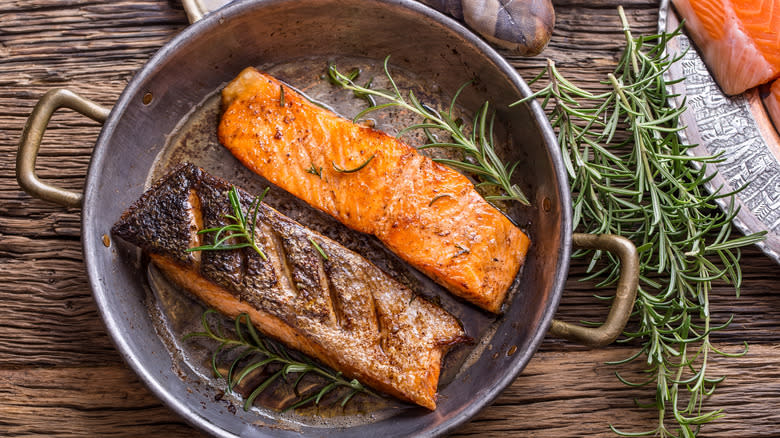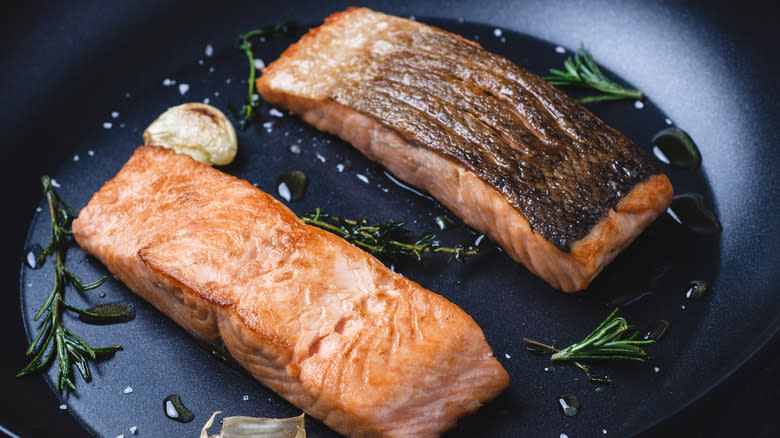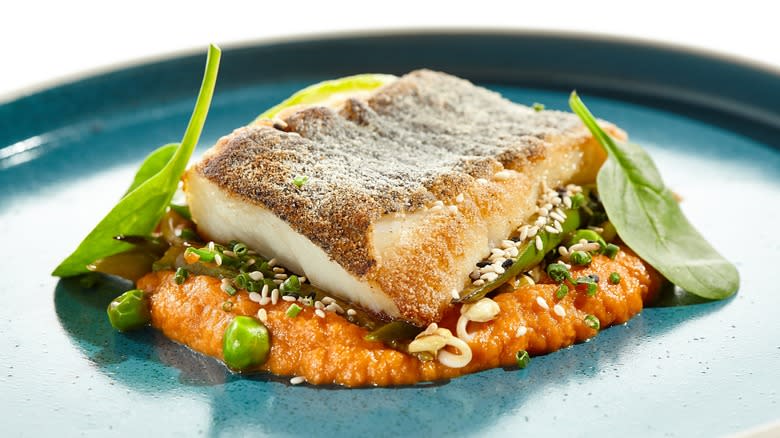Start Scoring Your Salmon Skin For Crispier Results

Salmon is a welcome centerpiece to any meal, for any occasion, during any season. It's versatile and sustaining, goes well with all kinds of sides, and is a candidate for a variety of cooking methods. Beyond that, it's packed with nutrients like omega-3 fatty acids, B vitamins, folic acid, potassium, and protein. That's to say nothing of its delicious, buttery, and lightly-sweet flavor — of which its skin is a major component.
If you typically toss your salmon skin because it ends up soggy, one way to get a satisfying textural contrast is an easy trick that will elevate your salmon no matter how you choose to cook it. Simply scoring the skin of your fish with a sharp knife about ½ inch into the flesh (leaving about a ¼ inch to ½ inch between incisions) will ensure that it doesn't curl up while it's being cooked, a common issue that hinders even crisping as it prevents the entire layer of skin from making contact with the hot surface. A flat-lying piece of fish means you'll have even crispness across the surface of the skin.
Read more: 12 Underrated Types Of Fish You Should Try At Least Once
What Makes Scoring So Important?

Scoring the skin of your salmon has multiple benefits from a cooking standpoint. Beyond keeping your fish from curling up, you'll find new places to pocket flavor. Scoring in a criss-cross pattern means you'll have more crevices in which your delicious seasoning can hide thanks to the additional openings. You can do this by cutting diagonally, then pivoting your fish 90 degrees and cutting again across your initial scores (this will look a little like a tic-tac-toe board). But you can also score straight across; just remember, the more incisions you make, the crispier the skin will be. Pressing down with a spatula once you place your salmon in the pan skin-side down will also help achieve an even sear.
While some may feel less drawn to the idea of eating the skin, there are plenty of good reasons to leave your salmon skin on. For one thing, as is the case for every creature, skin offers protection, so it'll help prevent the fragile flesh from overcooking. It also helps to keep your fish from falling apart during the cooking process and makes it much easier to flip (always start skin-side down) so, even if you decide to discard it in the end, it's good practice to leave the skin on while you sear the filet.
More Tips For Crispy Skin Salmon

Beyond scoring, a few additional tips can help ensure you have a fish with crispy skin. For one thing, be mindful when selecting your salmon. For the same reason that it's not a good idea to sear frozen fish, you'll want to avoid that here. The excess liquid that makes it difficult to get that sear will prevent your skin from crisping. Instead, prioritize purchasing fresh fish and then let it sit, skin-up, uncovered in the fridge for up to an hour, which will help dry the skin a bit, ultimately aiding in the crisping process by reducing moisture.
Using the "cold pan" method can help, too. This means placing your chilled fish skin-side down in an oiled pan before you turn the heat on and then bringing it up to high. As the pan comes up to temperature, press your scored fish down with a fish spatula, if possible (a tool that is actually perfect for other purposes, like cooking pancakes, and is the key to flipping eggs). Otherwise, you can use your standard spatula in a pinch. Coupled with scoring, these simple steps will add up to a satisfying, crispy-skinned fish you'll want to revisit regardless of the occasion.
Read the original article on Daily Meal

 Yahoo Finance
Yahoo Finance 